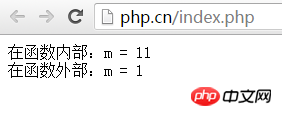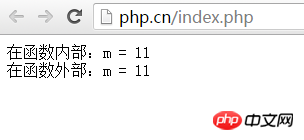 Backend Development
Backend Development
 PHP Tutorial
PHP Tutorial
 Detailed explanation of three ways to pass parameters of PHP custom functions between functions
Detailed explanation of three ways to pass parameters of PHP custom functions between functions
Detailed explanation of three ways to pass parameters of PHP custom functions between functions
When calling a function, you need to pass parameters to the function. The passed parameters become actual parameters, and the parameters when the function is defined are formal parameters. In the previous chapter, we explained the parameters of php custom functions with examples. This chapter focuses on the three ways of passing parameters between functions: Pass by value , Pass and default parameters by reference.
1. Pass by value
#Assign the value of the actual parameter to the corresponding formal parameter, and the operation inside the function is for The formal parameters are processed, and the result of the operation will not affect the actual parameters, that is, the values of the actual parameters will not change after the function returns. During the pass-by-value process, the formal parameters of the called function are treated as local variables of the called function, that is, a memory space is opened in the stack to store the values of the actual parameters put in by the calling function, so that Becomes a copy of the actual parameter. The characteristic of value transfer is that any operation of the formal parameters by the called function is performed as a local variable and will not affect the value of the actual parameter variable of the calling function.
First define a function example(), whose function is to perform some operations on the passed parameter value and then output it; then define a variable $m outside the function, which is the actual parameter; finally call the function example($ m). Output the values of formal parameter $m and actual parameter $m inside and outside the function body respectively.
The example code is displayed as follows:
<?php
function example($m){
$m = $m + 10;
echo "在函数内部:m = ".$m ."<br>"; //输出形参的值
}
$m = 1;
example($m); // 将实参$m的值传递给形参$m
echo "在函数外部:m = ".$m; // 实参的值没有变化,$m = 1
?>The running result of the function is as follows:

2. Passing by reference
Passing by reference is to pass the memory address of the actual parameter to the formal parameter. At this time, all operations on the formal parameters within the function will affect the values of the actual parameters. After the function returns, the value of the actual parameter will change. The way to pass by reference is to add the "& " symbol in front of the formal parameter when defining the function. During the pass-by-reference process, although the formal parameters of the called function also open up memory space on the stack as local variables, what is stored at this time is the address of the actual parameter variable put in by the calling function. Any operation of the called function on the formal parameters is processed as indirect addressing, that is, the actual parameter variables in the calling function are accessed through the address stored in the stack. Because of this, any operation the called function does on the formal parameters affects the actual parameter variables in the calling function.
The code example is as follows:
<?php
function example(&$m){ //定义一个函数,同时传递参数$m的地址
$m = $m + 10;
echo "在函数内部:m = ".$m ."<br>"; //输出形参的值
}
$m = 1;
example($m); // 将实参$m的地址传递给形参$m
echo "在函数外部:m = ".$m; // 实参的值发生了变化,$m = 11
?>The running result of the function is as follows:

3. Default parameters (optional parameters)
There is another way to set parameters, which is optional parameters. You can specify a parameter as optional, place the optional parameter at the end of the parameter list, and specify that its default value is empty.
Application example uses optional parameters to implement a simple price calculation function. Set the parameter $tax of the custom function values as an optional parameter, and its default value is empty. The first time the function is called, and the parameter $tax is assigned a value, the price is output; the second time the function is called, the parameter is not copied, and the price is output.
The code is as follows:
<?php
function value($price, $tax=""){ //定义一个函数,第二个参数为空
$price = $price*$tax;
echo "价格:$price<br>"; //输出价格
}
value(10,5); // 为可选参数赋值5
value(10); // 没有给可选参数赋值
?>The output result is:
Price: 50
Price: 0
Note: When using default parameters, the default parameters must be placed to the right of the non-default parameters, otherwise the function may Something went wrong.
Note: Starting from PHP5, default values can also be passed by reference. The next chapter will introduce What is the return value of a custom function.
【Recommended related tutorials】
1. "php.cn Dugu Jiujian (4)-php video tutorial"
2. php programming from entry to mastering a full set of video tutorials
3. php practical video tutorial
The above is the detailed content of Detailed explanation of three ways to pass parameters of PHP custom functions between functions. For more information, please follow other related articles on the PHP Chinese website!

Hot AI Tools

Undresser.AI Undress
AI-powered app for creating realistic nude photos

AI Clothes Remover
Online AI tool for removing clothes from photos.

Undress AI Tool
Undress images for free

Clothoff.io
AI clothes remover

AI Hentai Generator
Generate AI Hentai for free.

Hot Article

Hot Tools

Notepad++7.3.1
Easy-to-use and free code editor

SublimeText3 Chinese version
Chinese version, very easy to use

Zend Studio 13.0.1
Powerful PHP integrated development environment

Dreamweaver CS6
Visual web development tools

SublimeText3 Mac version
God-level code editing software (SublimeText3)

Hot Topics
 CakePHP Project Configuration
Sep 10, 2024 pm 05:25 PM
CakePHP Project Configuration
Sep 10, 2024 pm 05:25 PM
In this chapter, we will understand the Environment Variables, General Configuration, Database Configuration and Email Configuration in CakePHP.
 PHP 8.4 Installation and Upgrade guide for Ubuntu and Debian
Dec 24, 2024 pm 04:42 PM
PHP 8.4 Installation and Upgrade guide for Ubuntu and Debian
Dec 24, 2024 pm 04:42 PM
PHP 8.4 brings several new features, security improvements, and performance improvements with healthy amounts of feature deprecations and removals. This guide explains how to install PHP 8.4 or upgrade to PHP 8.4 on Ubuntu, Debian, or their derivati
 CakePHP Date and Time
Sep 10, 2024 pm 05:27 PM
CakePHP Date and Time
Sep 10, 2024 pm 05:27 PM
To work with date and time in cakephp4, we are going to make use of the available FrozenTime class.
 CakePHP File upload
Sep 10, 2024 pm 05:27 PM
CakePHP File upload
Sep 10, 2024 pm 05:27 PM
To work on file upload we are going to use the form helper. Here, is an example for file upload.
 CakePHP Routing
Sep 10, 2024 pm 05:25 PM
CakePHP Routing
Sep 10, 2024 pm 05:25 PM
In this chapter, we are going to learn the following topics related to routing ?
 Discuss CakePHP
Sep 10, 2024 pm 05:28 PM
Discuss CakePHP
Sep 10, 2024 pm 05:28 PM
CakePHP is an open-source framework for PHP. It is intended to make developing, deploying and maintaining applications much easier. CakePHP is based on a MVC-like architecture that is both powerful and easy to grasp. Models, Views, and Controllers gu
 CakePHP Creating Validators
Sep 10, 2024 pm 05:26 PM
CakePHP Creating Validators
Sep 10, 2024 pm 05:26 PM
Validator can be created by adding the following two lines in the controller.
 CakePHP Working with Database
Sep 10, 2024 pm 05:25 PM
CakePHP Working with Database
Sep 10, 2024 pm 05:25 PM
Working with database in CakePHP is very easy. We will understand the CRUD (Create, Read, Update, Delete) operations in this chapter.





